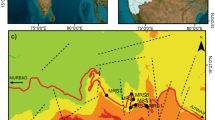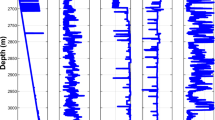Abstract
Uniaxial compressive strength (UCS) is one of the most significant factors in the stability of rock engineering projects and is vastly used during the design and construction stages of underground excavations. Distances between exploratory boreholes is typically large during the preliminary studies of a majority of geotechnical projects. As a result, estimation of UCS values based on the scant data obtained from these distant boreholes is crucially important. Thus, the use of geostatistical estimation and simulation methods can lead to a significant reduction of errors and exploratory costs. In this regard, the present paper ties simulation and estimation of UCS values of the rock material between boreholes of the Behesht-Abad tunnel in central Iran using the Stanford Geostatistical Modeling Software (SGEMS). Variography showed the acceptable spatial distribution (9,477 m) of UCS parameters in the area under investigation. Also, cross-validation proved the high accuracy (98 %) and reliability of the results of the developed model. Then, considering the condition of the datasets and engineering judgmentvalues, the model outcomes were analyzed. It was concluded there is high similarity between the geostatistical estimation/simulation and engineering judgments. Application of geostatistical simulation methods in conjunction with estimation in rock research indicates these methods are performed in a rather different aspect from those of common validation processes. Furthermore, the combination of geostatistical estimation/simulation and engineering judgment led to better identification of the pros and cons of geotechnical explorations in each tunnel route.















Similar content being viewed by others
References
Armstrong M (1998) Basic linear geostatistics. Springer, Berlin
Ayalew L, Reik G, Busch W (2002) Characterizing weathered rock masses—a geostatistical approach. Int J Rock Mech Min Sci 39(1):105–114
Brook N (1985) The equivalent core diameter method of size and shape correction in point load testing. Int J Rock Mech Mining Sci Geomech Abstr. Vol. 22. No. 2. Pergamon
Coates DF, Parsons RC (1966) Experimental criteria for classification of rock substances. Int J Rock Mech Mining Sci Geomech Abstr. Vol. 3, No. 3, pp 181–189. Pergamon
Costa JF, Zingano AC, Koppe JC (2000) Simulation—an approach to risk analysis in coal mining. Explor Min Geol 9(1):43–49
Del Potro R, Hürlimann M (2009) A comparison of different indirect techniques to evaluate volcanic intact rock strength. Rock Mech Rock Eng 42(6):931–938
Diamantis K, Gartzos E, Migiros G (2009) Study on uniaxial compressive strength, point load strength index, dynamic and physical properties of serpentinites from Central Greece: test results and empirical relations. Eng Geol 108(3):199–207
Dubrule O (2003) Geostatistics for seismic data integration in earth models: 2003 Distinguished Instructor Short Course. No. 6.SEG Books
Ellefmo SL, Eidsvik J (2009) Local and spatial joint frequency uncertainty and its application to rock mass characterisation. Rock Mech Rock Eng 42(4):667–688
Esfahani NM, Asghari O (2013) Fault detection in 3D by sequential Gaussian simulation of rock quality designation (RQD). Arab J Geosci 6(10):3737–3747
Gill DE, Corthésy R, Leite MH (2005) Determining the minimal number of specimens for laboratory testing of rock properties. Eng Geol 78(1):29–51
Gringarten E, Deutsch CV (2001) Teacher’s aide variogram interpretation and modeling. Math Geol 33(4):507–534
Hashemi M (2008) Rock mechanic’s reports, water supply project of the Central Plateau, Zayandehab Consulting, printed in farsi
Hoerger SF, Young DS (1987) Predicting local rock mass behavior using geostatistics. The 28th US Symposium on Rock Mechanics (USRMS)
Journel AG (1988) Fundamentals of geostatistics in five lessons, vol 8. American Geophysical Union, Washington, DC
Krige DG (1951) A statistical approach to some basic mine valuation problems on theWitwatersrand. J Chem Metall Mining Soc S Afr 52:119–139
La Pointe PR (1980) Analysis of the spatial variation in rock mass properties through geostatistics. The 21st US Symposium on Rock Mechanics (USRMS)
Manouchehrian A, Sharifzadeh M, Hamidzadeh MR (2012) Application of artificial neural networks and multivariate statistics to estimate UCS using textural characteristics. Int J Mining Sci Technol 22(2):229–236
Mark C, Williams LM, Pappas D, Rusnak J (2004) Spatial trends in rock strength: can they be determined from coreholes. In: Proceedings of the 23rd International Conference on Ground Control in Mining. Morgantown, WV: West Virginia University, pp 177B182
Mishra DA, Basu A (2013) Estimation of uniaxial compressive strength of rock materials by index tests using regression analysis and fuzzy inference system. Eng Geol 160:54–68
Monjezi M, Amini KH, Razifard M (2012) A neuro-genetic network for predicting uniaxial compressive strength of rocks. Geotech Geol Eng 30(4):1053–1062
Oh S (2013) Geostatistical integration of seismic velocity and resistivity data for probabilistic evaluation of rock quality. Environ Earth Sci 69:939–945
Ozbek A, Unsal M, Dikec A (2013) Estimating uniaxial compressive strength of rocks using genetic expression programming. J Rock Mech Geotech Eng 5(4):325–329
Ozturk CA, Nasuf E (2002) Geostatistical assessment of rock zones for tunneling. Tunn Undergr Space Technol 17(3):275–285
Ozturk CA, Simdi E (2014) Geostatistical investigation of geotechnical and constructional properties in Kadikoy-Kartal subway, Turkey. Tunn Undergr Space Technol 41:35–45
Rajashekhar MR, Ellingwood BR (1993) A new look at the response surface approach for reliability analysis. Struct Saf 12(3):205–220
Remy N, Boucher A, Wu J (2009) Applied geostatistics with SGeMS: a user’s guide. Cambridge University, Cambridge
Rosenbaum MS, Rosén L, Gustafson G (1997) Probabilistic models for estimating lithology. Eng Geol 47(1):43–55
Ruffolo RM, Shakoor A (2009) Variability of unconfined compressive strength in relation to number of test samples. Eng Geol 108(1):16–23
Sacks J, Welch WJ, Mitchell TJ, Wynn HP (1989) Design and analysis of computer experiments. Stat Sci 4(4):409–423
Stavropoulou M, Exadaktylos G, Saratsis G (2007) A combined three-dimensional geological–geostatistical–numerical model of underground excavations in rock. Rock Mech Rock Eng 40(3): 213–243
Stright L, Bernhardt A, Boucher A (2013) DFTopoSim: modeling topographically-controlled deposition of subseismic scale sandstone packages within a mass transport dominated deep-water channel belt. Math Geosci 45(3):277–296
Vann J, Bertoli O, Jackson S (2002) An overview of geostatistical simulation for quantifying risk. Geostatistical Association of Australian symposium 1:1
Yilmaz I (2009) A new testing method for indirect determination of the unconfined compressive strength of rocks. Int J Rock Mech Min Sci 46(8):1349–1357
Yilmaz I, Sendir H (2002) Correlation of Schmidt hardness with unconfined compressive strength and Young’s modulus in gypsum from Sivas (Turkey). Eng Geol 66(3):211–219
Acknowledgments
The authors would like to acknowledge the Zayandehab Consulting group for providing quality laboratory and field data for this research.
Author information
Authors and Affiliations
Corresponding author
Rights and permissions
About this article
Cite this article
Doostmohammadi, M., Jafari, A. & Asghari, O. Geostatistical modeling of uniaxial compressive strength along the axis of the Behesht-Abad tunnel in Central Iran. Bull Eng Geol Environ 74, 789–802 (2015). https://doi.org/10.1007/s10064-014-0663-z
Received:
Accepted:
Published:
Issue Date:
DOI: https://doi.org/10.1007/s10064-014-0663-z




